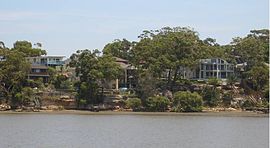Oyster Bay, New South Wales
|
Oyster Bay Sydney, New South Wales |
|||||||||||||
|---|---|---|---|---|---|---|---|---|---|---|---|---|---|

Oyster Bay
|
|||||||||||||
| Established | 1933 | ||||||||||||
| Postcode(s) | 2225 | ||||||||||||
| Location | 26 km (16 mi) south of Sydney CBD | ||||||||||||
| LGA(s) | Sutherland Shire | ||||||||||||
| State electorate(s) | Miranda | ||||||||||||
| Federal Division(s) | Hughes | ||||||||||||
|
|||||||||||||
Oyster Bay is a suburb in Southern Sydney, in the state of New South Wales, Australia. Oyster Bay is located 26 kilometres south of the Sydney central business district in the local government area of the Sutherland Shire.
Oyster Bay is a natural feature on the southern bank of the Georges River. The suburb which takes its name from the waterway is a picturesque residential area.
Green Point and Caravan Head are localities within the suburb of Oyster Bay. Green Point is home to the Green Point Observatory, home of the Sutherland Astronomical Society. Coronation Bay is also located on the Georges River between Green Point and Caravan Head. At Coronation Bay there is a large mangrove area that creates a diverse and dynamic eco-system, which supports a variety of bird-life. Carina Bay is located on the western boundary of the suburb.
Oyster Bay takes its name simply from the abundance of oysters that were found in the bay. The name had appeared on maps prepared by Surveyor Wells in 1840. Oyster Bay was part of the Thomas Holt Estate of 12,000 acres purchased in 1861 by Thomas Holt (1811-1888), pastoralist and at one time, Colonial Treasurer of New South Wales. His Estate covered most of present day Sutherland Shire. Parish maps dating from 1880 show Scylla and Carina Roads clearly dissecting the area known as Oyster Bay. These were boundary lines between the individual Holt acreages. The Parish Map of 1913 shows a subdivision, called “By the Water Estate”, with an early alignment of Caravan Head, Como and Oyster Bay Roads. The first house, situated at 19 Como Road was built in 1910. It belonged to Samuel and Eliza Hall. A general store was opened in 1925. The 1925 Parish Map has “The Village of Oyster Bay” written on it. The suburb's name was officially recognised in 1933. Oyster Bay Public School was opened in 1945. Oyster Bay developed after this with post World War II migration creating a need for the release of land for housing. An interesting feature of Oyster Bay is that steps and pathways, which were built during the 1930s, provide pedestrian access from the highest part of the suburb to the shops beside the bay. Steps and a pathway also lead from Green Point to Como, giving access to the old Como railway station and to Como Public School (est. 1921).
...
Wikipedia
